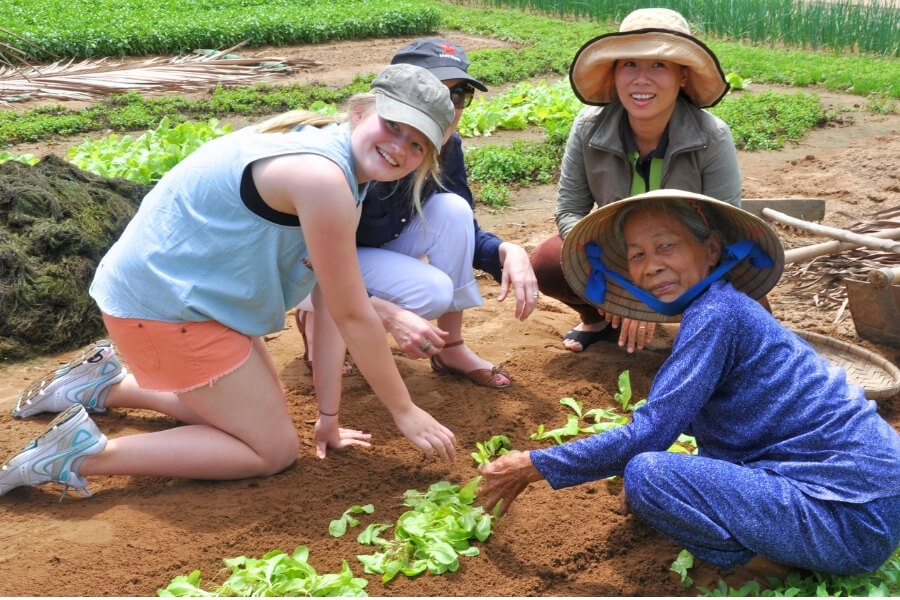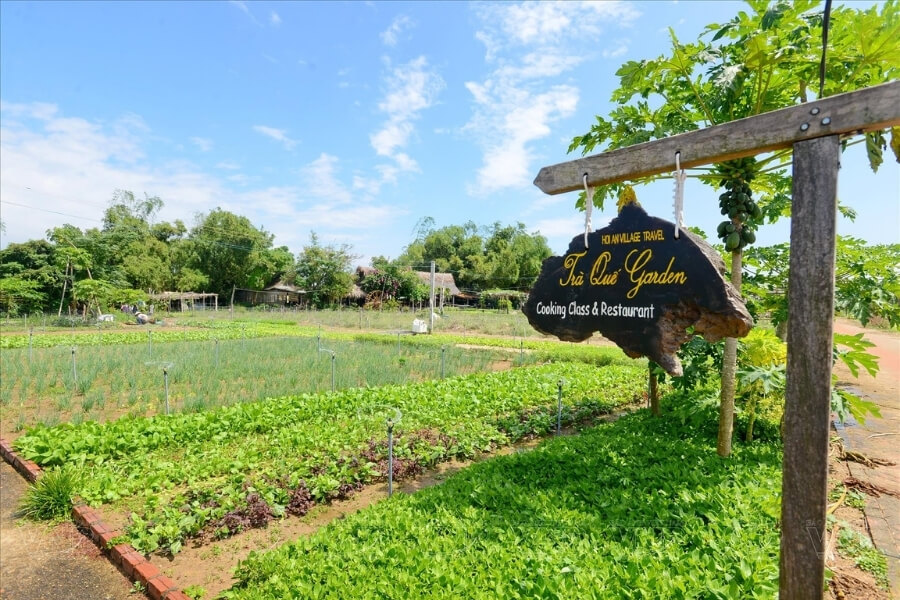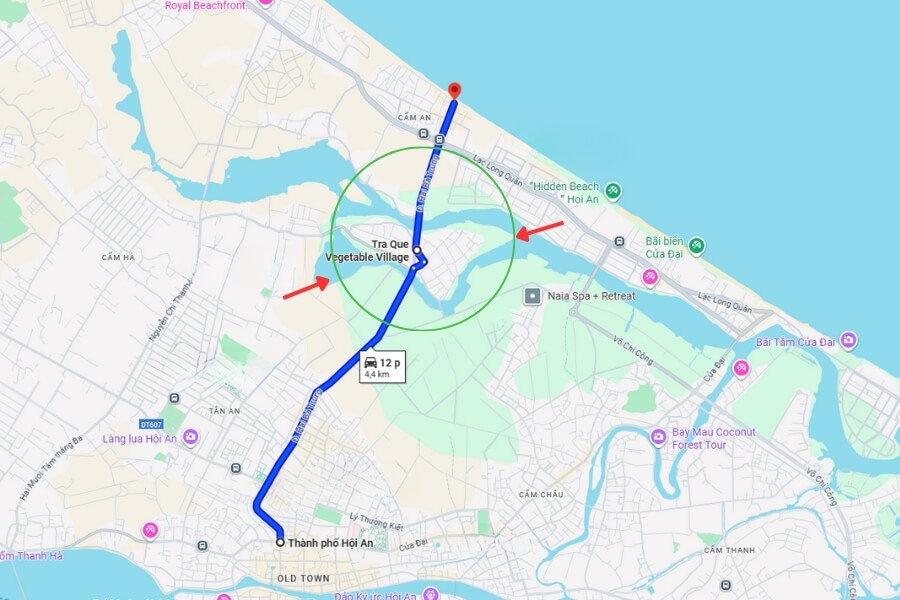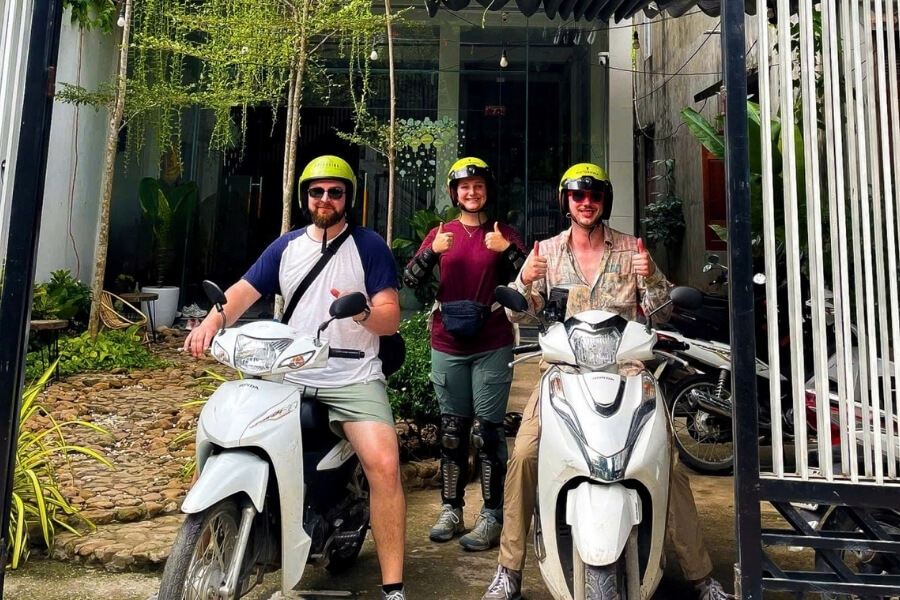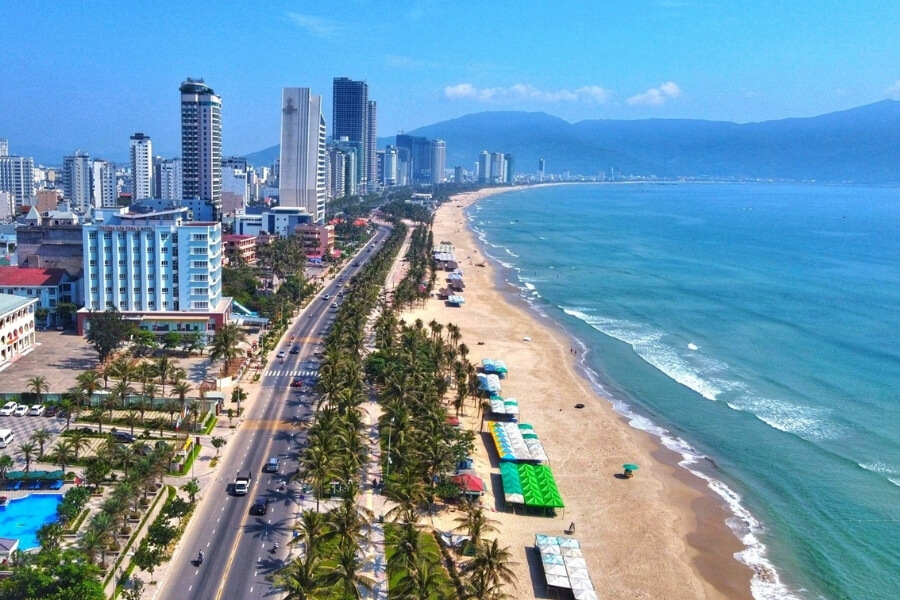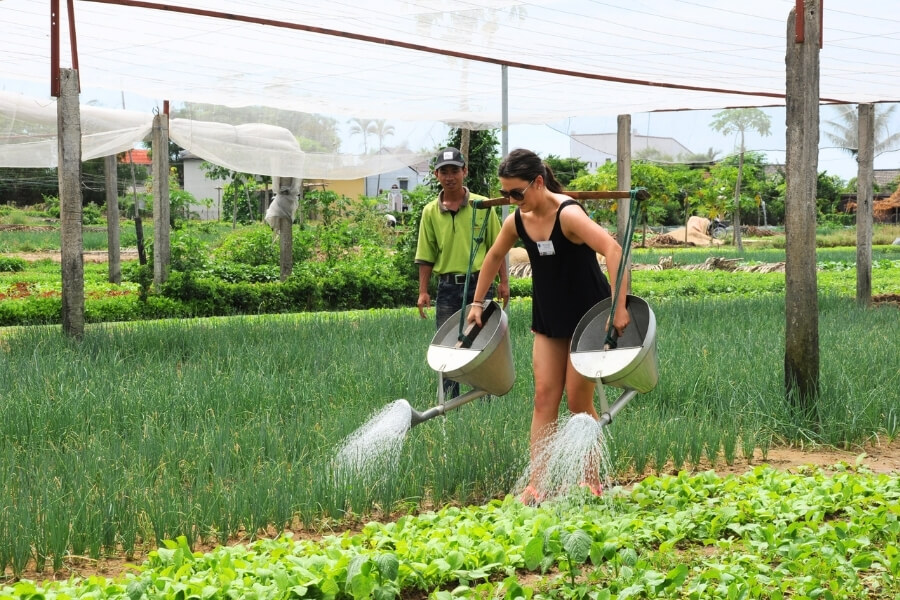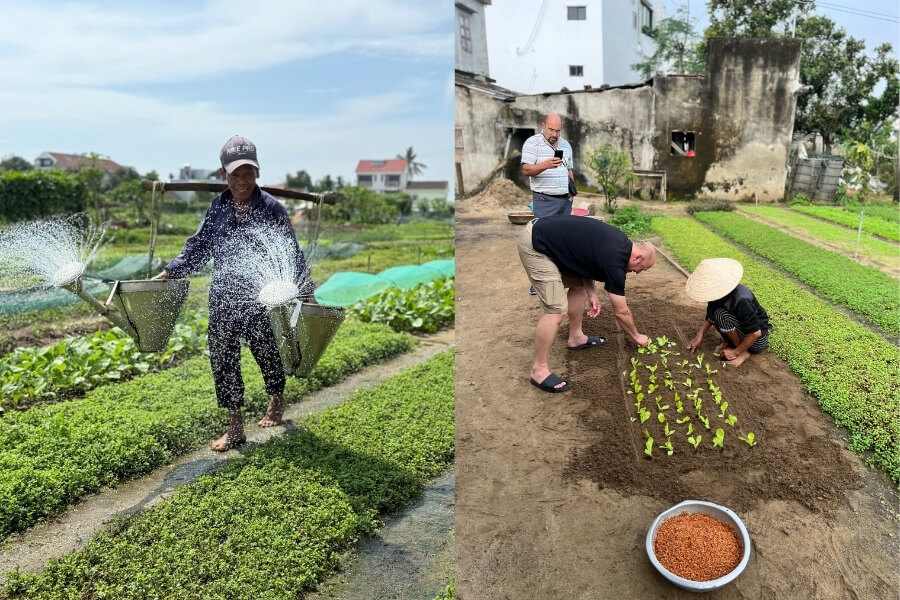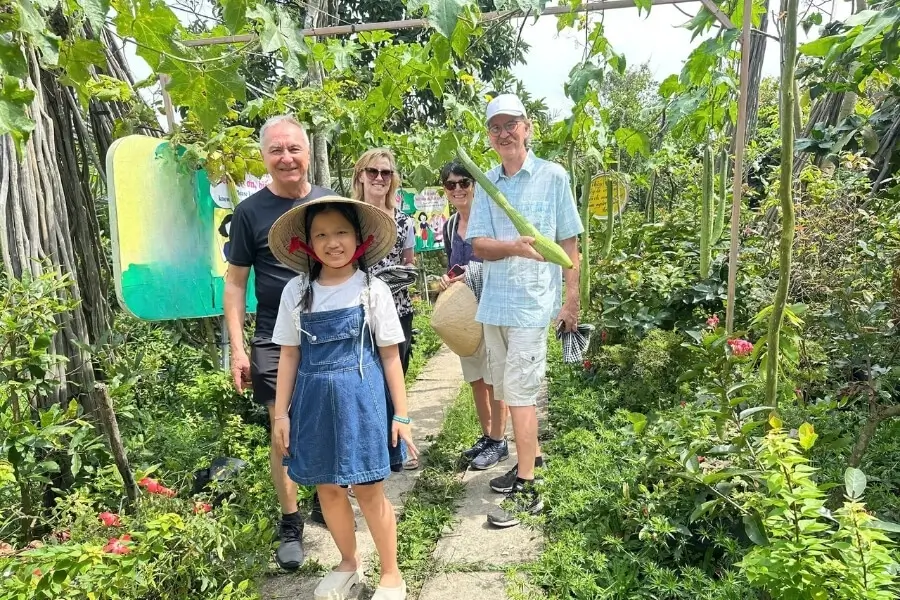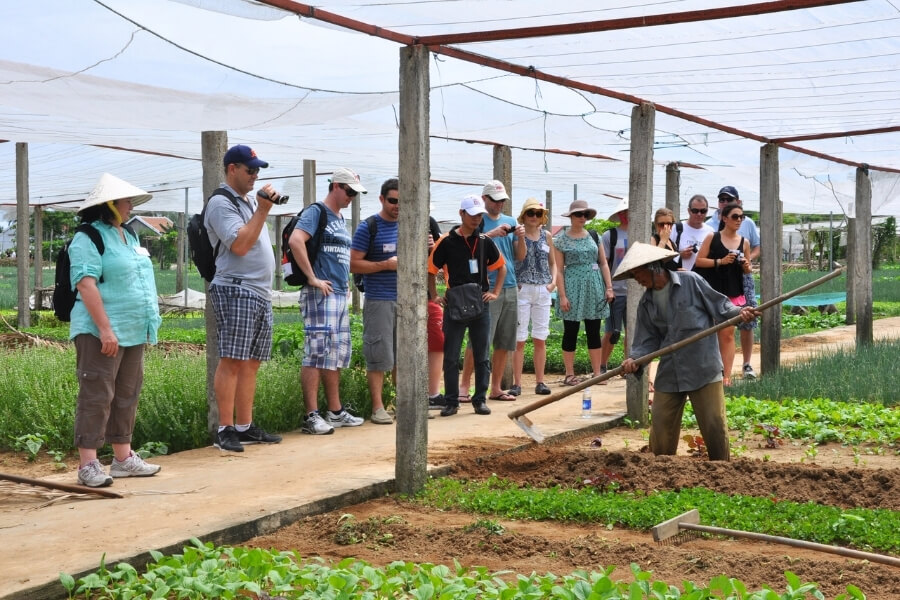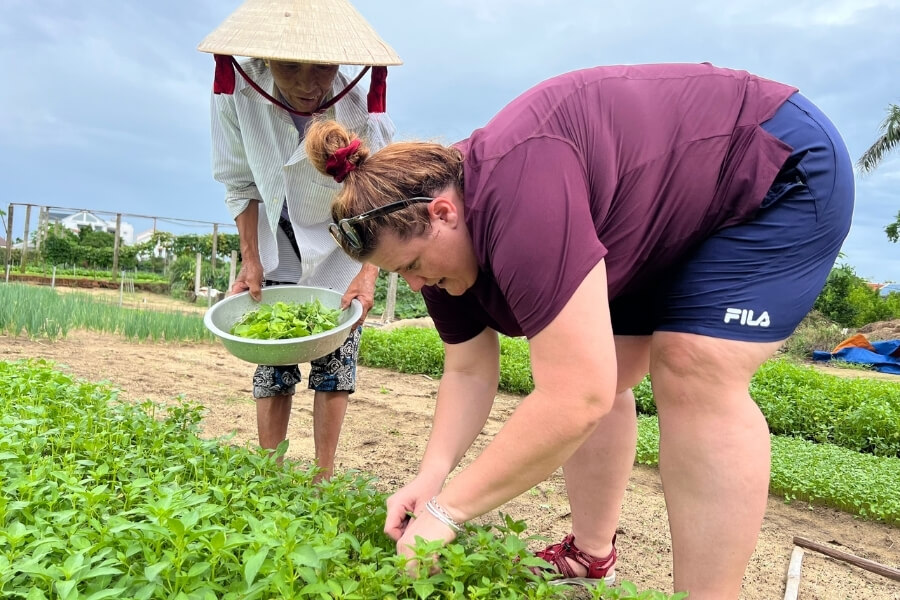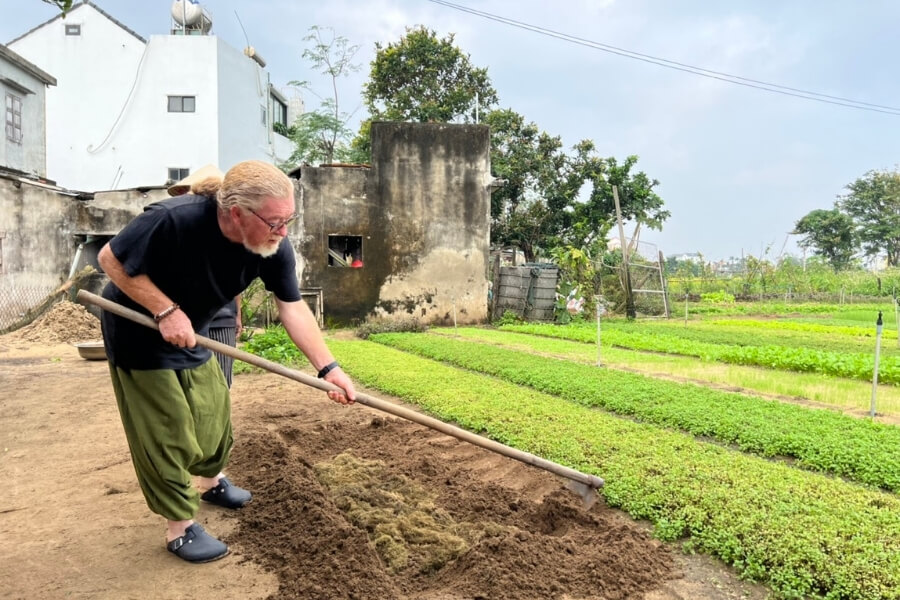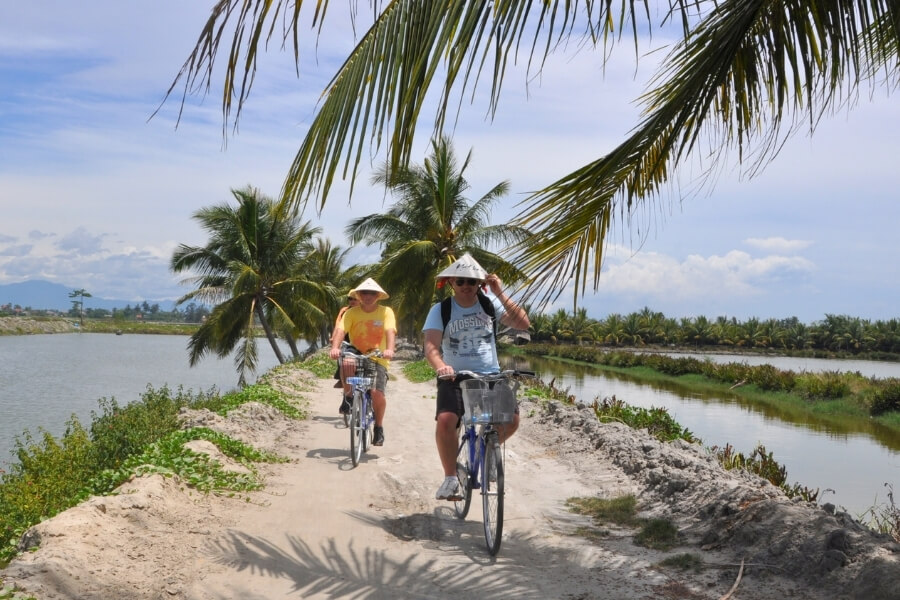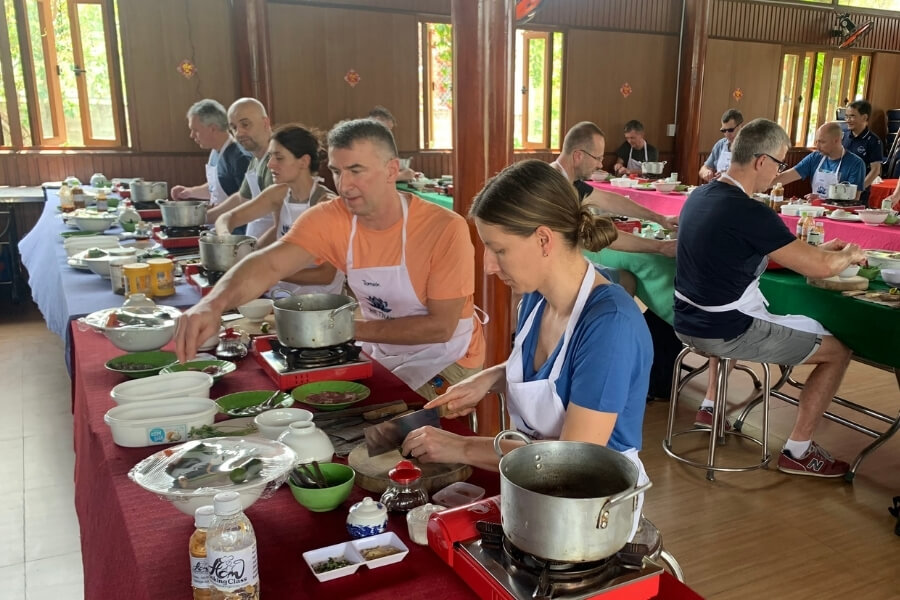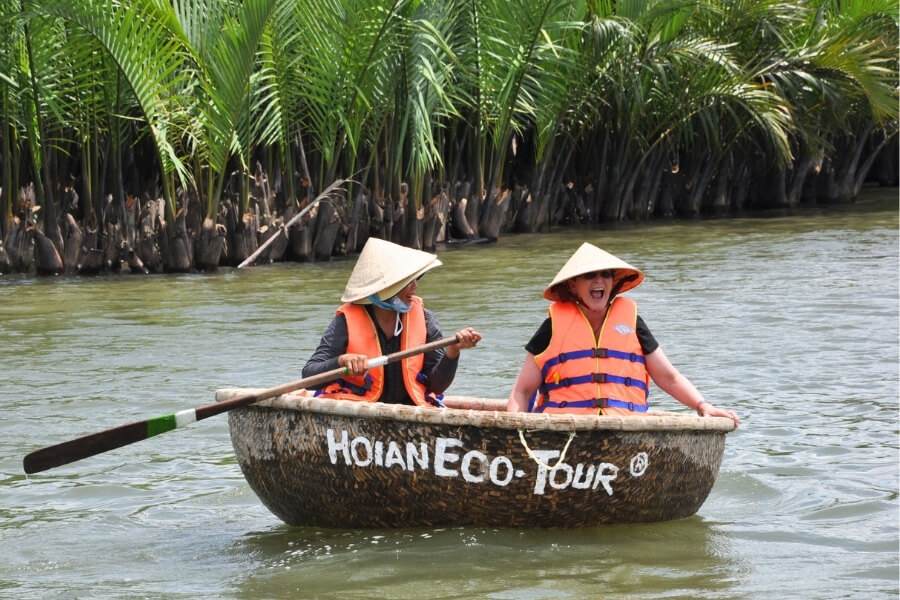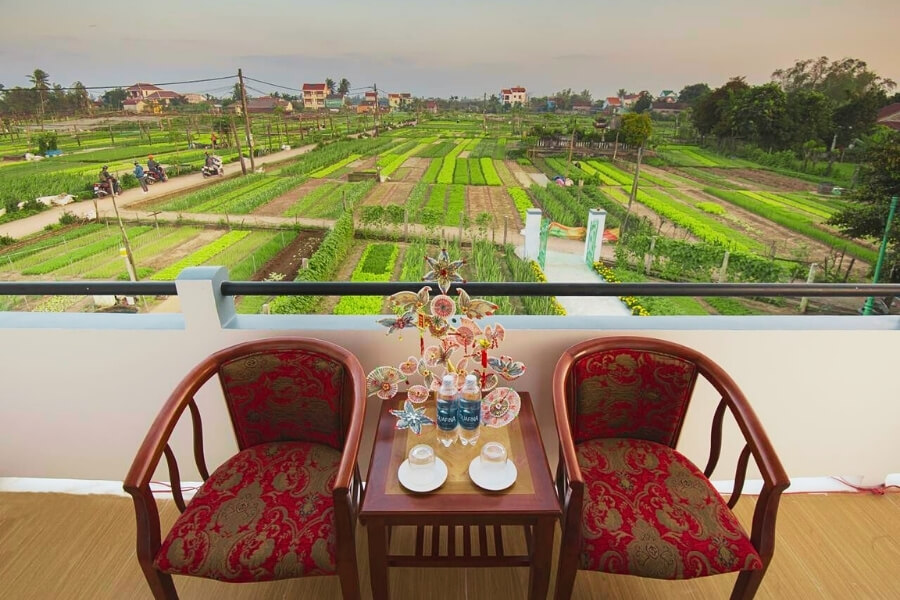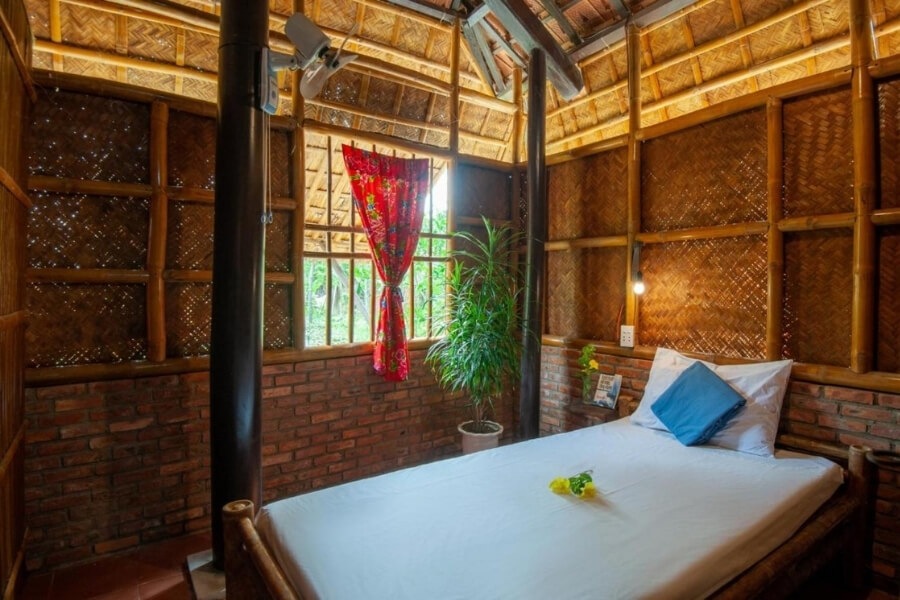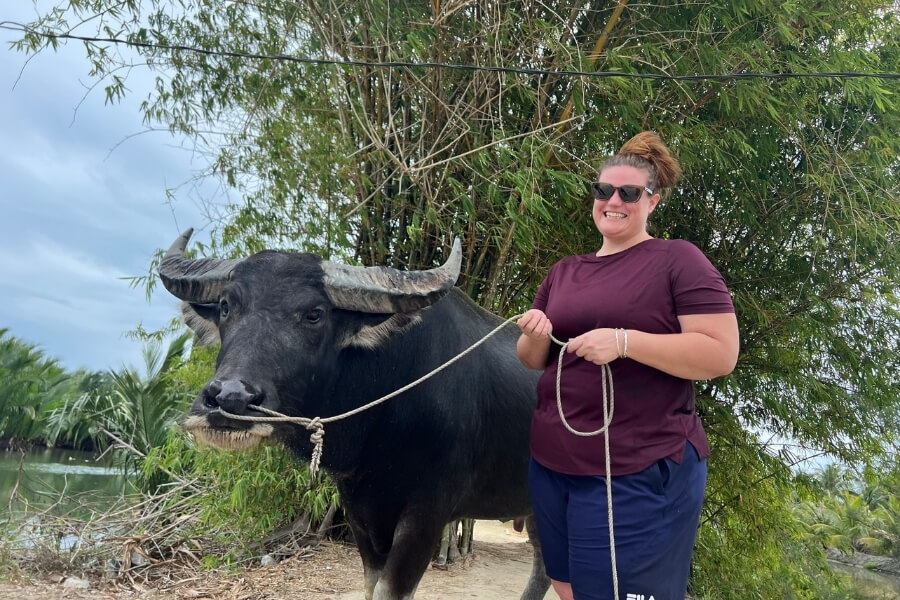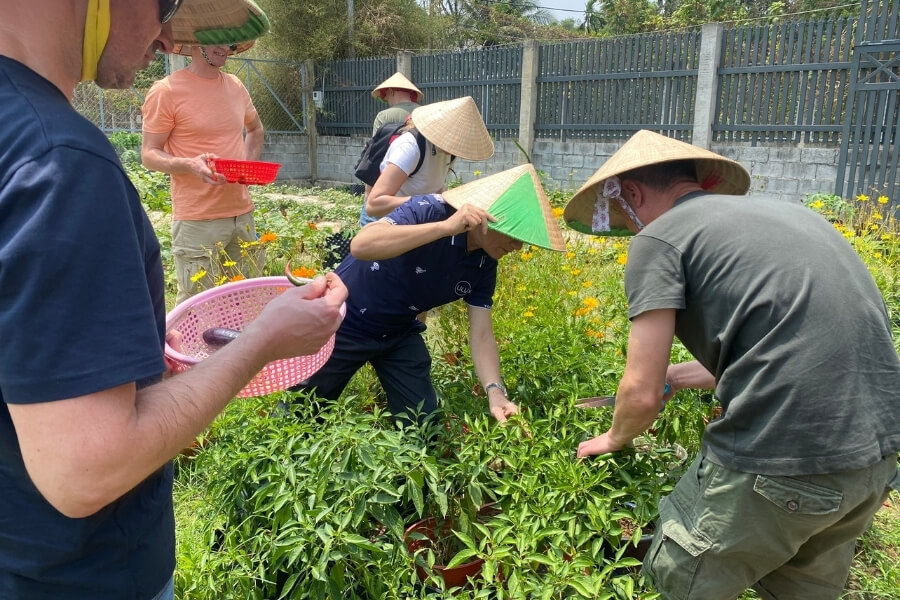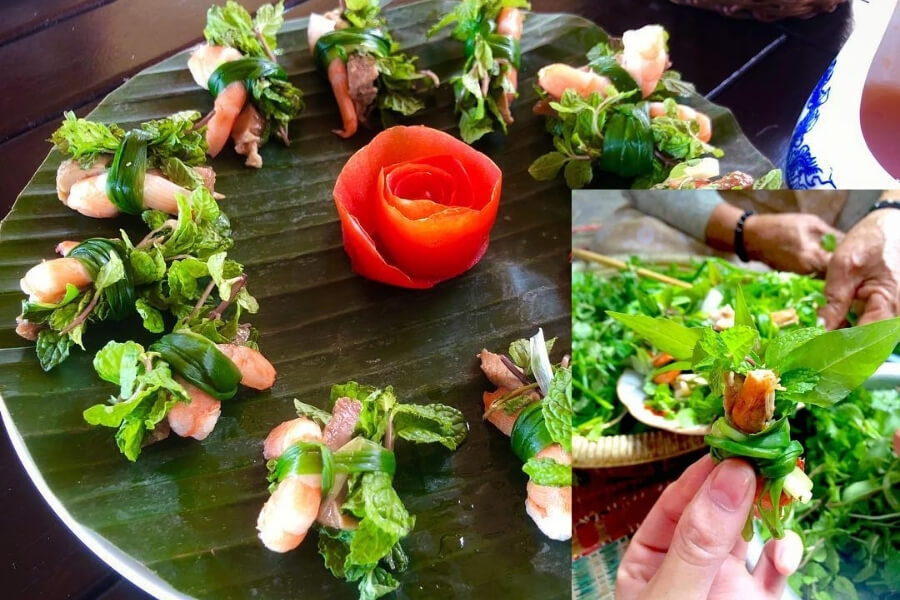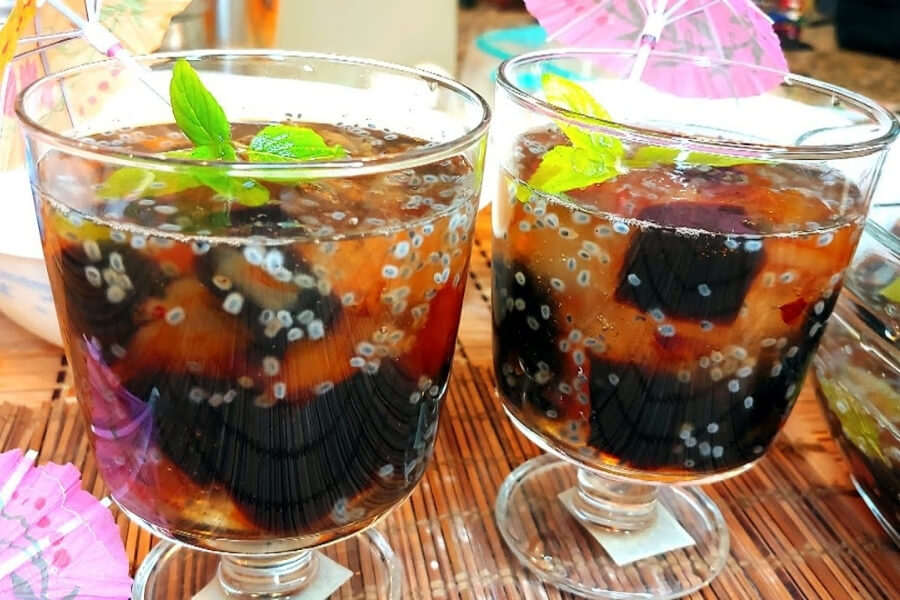Tucked away in the tranquil embrace of central Vietnam, Tra Que Vegetable Village - often featured in many Indochina tours - feels like a secret whispered by the countryside. Just a stone’s throw from the lively lantern-lit streets of Hoi An Ancient Town, this verdant haven, also known as Hoi An Vegetable Village, beckons travelers to slow down and savor the rhythm of rural life. Imagine strolling through fields where the air hums with the crisp scent of basil, lemongrass, and mint, each breath a gentle reminder of nature’s quiet magic. Honored by the United Nations in 2024 as one of the world’s finest tourism villages, Tra Que isn’t just a place to see - it’s a place to feel, where the soul of Vietnamese countryside culture comes alive through sustainable farming and timeless traditions.
Picture farmers in conical hats, their hands coaxing life from the rich soil, creating a symphony of green that blends human effort with the land’s generosity. From digging into the earth during a farming workshop to savoring a plate of Tam Huu rolls crafted with herbs picked moments before, every experience here radiates warmth and authenticity. This guide is designed to light the way for travelers eager to uncover Tra Que’s treasures, offering practical advice, immersive activities, and a window into the village’s enduring charm, all woven together for a journey that’s as seamless as it is unforgettable.
Discovering the Location of Tra Que Vegetable Village
Tra Que Vegetable Village is a hidden gem just 3 kilometers northeast of Hoi An Ancient Town, in Cam Ha Commune, Quang Nam Province. Its proximity to Hoi An makes it an ideal day trip, while its location between the De Vong River and Tra Que Algae Pond creates a fertile oasis perfect for organic farming. Spanning 40 hectares, the village supplies fresh produce to local markets and restaurants, making it a vital part of the region’s culinary scene.
Where Exactly Is Tra Que Village?
Situated along Hai Ba Trung Street, Tra Que is easily accessible from Hoi An’s bustling center. The village is divided into eastern and western zones, each offering distinct experiences. The eastern side features historical landmarks like ancient stone wells, while the western side is livelier, often hosting tour groups exploring the Tra Que Herb Garden. Its location, just 26 kilometers from Da Nang, also makes it a convenient stop for those exploring the broader Quang Nam-Da Nang region.
Why Its Location Matters
The village’s position between Hoi An and An Bang Beach allows travelers to combine a visit with other attractions, creating a seamless itinerary. The surrounding rice fields and waterways, including the nearby Co Co River, enhance the scenic beauty, offering picturesque views that make every journey visually spectacular. This strategic spot underscores Tra Que’s role as a bridge between urban exploration and rural tranquility, appealing to those seeking a balanced travel experience.
Getting to Tra Que Vegetable Village
Reaching Tra Que Vegetable Village is an adventure in itself, with multiple transport options catering to different preferences. Whether cycling through rice paddies or arriving by motorbike, the short journey from Hoi An promises scenic delights and a refreshing change of pace.
Cycling: The Scenic Route
Cycling is the most popular way to reach Tra Que, taking about 15-20 minutes from Hoi An. Bicycles can be rented for 30,000-50,000 VND per day, often complimentary at local hotels or guesthouses. The flat, quiet roads lined with rice fields and herb gardens make for an enjoyable ride, perfect for soaking in the countryside’s charm. Early mornings offer cooler temperatures and a chance to see farmers at work.
Motorbike or Taxi Options
For quicker travel, motorbikes are available for rent at 100,000-200,000 VND daily. Note that some village paths restrict motorized vehicles to preserve the peaceful environment, so parking at the entrance is common. Grab ridesharing or traditional taxis offer convenience, with fares starting at 50,000 VND from Hoi An. For groups, private cars or organized tours provide comfort, though a short walk from the parking area may be required.
From Da Nang and Beyond
Travelers from Da Nang can take the Son Tra-Dien Ngoc road toward Hoi An, turning at intersections leading to Hai Ba Trung Street. The 45-minute drive offers glimpses of coastal and rural landscapes. Organized tours often include round-trip transfers, blending convenience with guided insights into the village’s history and culture.
The Historical and Cultural Roots of Tra Que Vegetable Village
Tra Que Vegetable Village is steeped in over 300 years of history, reflecting the resilience and ingenuity of its people. Its story is one of adaptation, community, and a deep connection to the land, making every visit a journey through time.
A Legacy of Farming and Migration
Founded in the 17th century by northern Vietnamese families, including clans like Pham, Nguyen, and Le, Tra Que began as a fishing and farming community. The fertile island, surrounded by rivers, proved ideal for vegetable cultivation. Traces of earlier Cham inhabitants, such as stone wells predating the 14th century, add archaeological depth to the village’s narrative.
The Royal Naming of Tra Que
In the early 18th century, Emperor Minh Mang, struck by the aroma of the village’s herbs during a boat trip along the Co Co River, named it “Tra Que,” meaning “tea and cinnamon.” This royal recognition elevated its status, and today, the village celebrates its heritage through festivals like Cau Bong, held on the seventh day of the first lunar month, where locals pray for prosperous harvests and showcase culinary traditions.
A National Cultural Treasure
In 2022, Vietnam’s Ministry of Culture, Sports, and Tourism designated Tra Que’s traditional vegetable-growing techniques as National Intangible Cultural Heritage. Landmarks like the Tomb of Nguyen Dien, a 19th-century mandarin, and the Tra Que Stone Well offer tangible connections to this legacy, enriching visits with stories of cultural continuity and sustainable practices.
Exploring the Tra Que Herb Garden
The Tra Que Herb Garden is the soul of the village, a vibrant patchwork of organic plots that produce over 20 varieties of herbs and vegetables. From basil to lemongrass, these crops are grown using natural methods, with algae from the nearby lagoon serving as fertilizer.
A Sensory Journey Through the Gardens
Walking through the garden, visitors are enveloped by the earthy scent of soil and the vivid greens of neatly arranged plots. The use of organic techniques, like crop rotation and intercropping, ensures soil vitality, offering a glimpse into sustainable farming. The garden’s beauty lies in its simplicity - small ponds for irrigation and colorful flowers like daisies create a serene, photogenic setting.
Learning from Local Farmers
Farmers often share their expertise, explaining how they cultivate herbs without chemicals. These interactions transform the garden into a living classroom, where visitors gain insights into eco-friendly agriculture. The tranquil ambiance, with sunlight filtering through leaves, invites moments of reflection, making it a highlight for nature lovers.
Must-Do Activities in Tra Que Vegetable Village
Tra Que offers a range of activities that blend education, adventure, and relaxation, ensuring every visitor leaves with memorable experiences. These activities highlight the village’s commitment to sustainable tourism and cultural immersion.
Hands-On Farming Experience
Joining a farming session is a standout activity, where visitors wear conical hats and work alongside locals to plant, water, and harvest crops using traditional tools like bamboo watering poles. These sessions, often lasting 2-3 hours, reveal the effort behind the village’s 8-ton annual yield, fostering appreciation for organic farming.
Cycling Through the Countryside
Cycling tours weave through rice paddies, lotus swamps, and riverside paths, offering a deeper exploration of the village’s surroundings. These guided rides, typically 3-4 hours, uncover hidden gems like bamboo fish traps and provide ample photo opportunities against the backdrop of rural scenery.
Cooking Classes with Fresh Herbs
Cooking classes let visitors harvest ingredients from the Tra Que Herb Garden and prepare dishes like Quang noodles or banh xeo pancakes. Led by local chefs, these classes emphasize “garden-to-table” dining, culminating in a meal that celebrates the village’s fresh flavors.
Cultural and Relaxation Activities
Exploring historical sites like the Tra Que Victory memorial or ancient wells adds depth to the visit, while herbal foot baths offer soothing relaxation. These activities, often included in guided tours, provide a well-rounded experience that balances learning and leisure.
Immersive Local Experiences at Tra Que Village House
Visiting a Tra Que Village House offers an intimate look at rural life, where families open their homes to share traditions and hospitality. These encounters create a sense of connection that elevates the travel experience.
Inside a Tra Que Village House
Traditional homes, often surrounded by private gardens, serve as venues for cultural exchanges. Guests might enjoy tea with locals, learn about herbal remedies, or hear the haunting melodies of the Dan Bau instrument. These moments offer authentic glimpses into daily life and ancestral customs.
Homestays for Deeper Immersion
While homestays are more common in nearby areas like Cam Thanh, some Tra Que families offer overnight stays. Sleeping in a village house, surrounded by the quiet of the countryside, allows travelers to fully absorb the village’s peaceful rhythm and build meaningful connections with residents.
Best Time to Visit and Practical Tips
Planning a visit to Tra Que Vegetable Village requires attention to timing and preparation to ensure a comfortable and rewarding experience.
Ideal Seasons for Visiting
The best times to visit are February to April and August to December, when mild weather enhances outdoor activities and the gardens are at their peak. Early mornings (7-10 AM) or late afternoons (3-5 PM) avoid the midday heat and align with farmers’ schedules for more interactive experiences.
Essential Travel Tips
- Dress Comfortably: Wear lightweight clothing and sturdy shoes for walking or farming activities. A hat and sunscreen are advisable for sun protection.
- Respect Local Customs: Ask permission before photographing people, and avoid stepping on garden plots.
- Book Tours: Guided tours, costing 300,000-600,000 VND, provide language support and curated experiences, ideal for first-time visitors.
- Combine Visits: Pair Tra Que with nearby attractions like Cam Thanh Coconut Village or An Bang Beach for a full day of exploration.
Savoring the Flavors of Hoi An Vegetable Village
The culinary offerings of Tra Que Vegetable Village are a highlight, showcasing the freshness and quality of its organic produce in every dish.
Signature Dishes to Try
Dishes like Tam Huu rolls, featuring shrimp, pork, and Tra Que herbs wrapped in rice paper, capture the village’s essence. Quang noodles, with their chewy texture and herb-infused broth, are another must-try, reflecting Quang Nam’s culinary heritage. Local restaurants serve these dishes using ingredients harvested that day, ensuring unparalleled freshness.
Refreshing Herbal Drinks
Beverages like É juice, blending basil, lime, and ginger, offer a cooling complement to meals. These drinks, served at village eateries or during tours, highlight the versatility of Tra Que’s herbs and provide a refreshing end to a day of exploration.
Why Tra Que Vegetable Village Stands Out
Tra Que Vegetable Village is more than a destination - it’s an invitation to connect with nature, culture, and community. Its organic gardens, historical roots, and warm hospitality create an experience that feels both grounding and uplifting. Whether cycling through its fields, harvesting herbs, or sharing stories with locals, visitors leave with a renewed appreciation for sustainable living and Vietnam’s rural charm.
For those planning a trip to Hoi An, Tra Que is an unmissable stop that promises memories as vibrant as its greenery. Start planning today - grab a bicycle, book a tour, or simply wander the paths of this enchanting village to discover its timeless allure.

